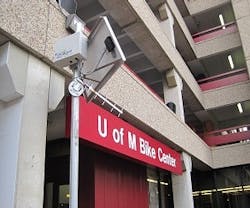University of Minnesota’s Solar-Powered Bike Commute
Universities and colleges, offices and buildings, and private and public facilities alike are promoting commutes by bike as environmentally friendly and healthy transportation. The lack of a practical, reliable way to tally bike trips has held back their efforts to provide incentives to encourage more biking.
The University of Minnesota is deploying a solution for managing and monitoring bike commuting: Dero ZAP, a solar-powered, automated RFID (Radio Frequency Identification) system with integrated hardware and software.
Every day up to 68,000 people (students, faculty and staff) arrive at the Twin Cities Campus of the University of Minnesota. About 30% live close enough so they walk. Just under 40% come by car (driving alone or carpooling). Only seven percent bike to campus.
60% of students, faculty and staff live within five miles of the campus. The University would like to see more of them biking rather than driving.
Dero ZAP uses the same technology as RFID systems that identify eligible automobiles for single-occupancy drivers who pay for the privilege of using High Occupancy Vehicle (HOV) lanes on highways. However, with Dero ZAP, instead of promoting car traffic, the technology is used to encourage a commute by bike.
Bike commuting managers use a simple web-based interface to the Dero ZAP system software to enroll participants and register a unique RFID tag to each rider. The tamper-proof tags are attached to the spokes of bikes’ front wheels. Solar-powered ZAP units, mounted on steel poles, identify registered bikes from up to 30 feet away.
When an enrolled bicyclist rides into the zone of a ZAP station, the unit acknowledges their arrival with an audible beep and flashing light. The ZAP unit records the arrival and transmits the data wirelessly to a central web server. Administrators access the data via the web to tally bike commuter arrivals, determine eligibility for incentives, and calculate rewards. The data also support analysis of bicycling transportation patterns.
The University of Minnesota has begun installing 20 Dero ZAP units at its Minneapolis and St. Paul campuses.
